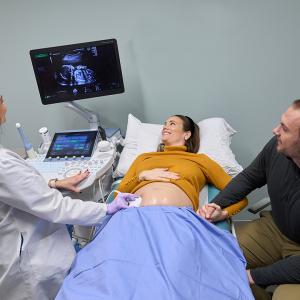
Dr. Boris Reizis, PhD, Dr. Jill P. Buyon, Dr. Gregg J. Silverman, Dr. Peter M. Izmirly, and Dr. Robert M. Clancy, PhD, lead National Institutes of Health-funded lupus research.
PHOTO: JULIANA THOMAS
Backed by a major National Institutes of Health grant, researchers are in pursuit of new insights to determine the mechanisms by which systemic lupus erythematosus (SLE) is initiated and perpetuated. The project will explore why some women who have anti-SSA/Ro antibodies never develop lupus while others do.
The program leverages unique patient resources, one a cohort of asymptomatic women presenting with a breakdown in B cell tolerance identified because of neonatal lupus (NL) in an offspring, and the other a robustly phenotyped cohort of established SLE patients spanning diverse racial backgrounds and with a high penetrance of serious illness.
The five-year, $6.7 million project combines the expertise of five investigators at NYU Langone, led by Jill P. Buyon, MD, the Lady Va and Sir Deryck Maughan Professor of Rheumatology, director of the Division of Rheumatology, and director of the Lupus Center. Through the newly launched Translational Center of Molecular Profiling in Preclinical and Established Lupus (COMPEL), the team hopes to discover the underpinnings of SLE’s initiation and progression. The program includes three main research arms.
One, led by Robert M. Clancy, PhD, associate professor of medicine, will investigate associations between immunogenetics and the microbiome to determine why lupus emerges or remains dormant in at-risk women.
Another arm, led by Gregg J. Silverman, MD, professor of medicine and pathology, will sequence gut microbiomes in established lupus patients and analyze the gut-associated B cell response to assess the root of disease flares and, in particular, the involvement and progression of kidney injury.
A third arm, led by Boris Reizis, PhD, professor of medicine and pathology, will investigate the fundamental enzyme DNase 1L3, which is essential for protection against SLE, and will explore how dysfunction of this enzyme may provide clues to the origins of disease and contribute to fluctuations in established disease.
The clinical core is directed by Peter M. Izmirly, MD, assistant professor of medicine. One of the clinical groups comprises women who have had a child born with congenital heart block or a skin rash and who have anti-SSA/Ro antibodies but were asymptomatic at the time their child was diagnosed.
Dr. Buyon says researchers still know relatively little about the factors that contribute to the mothers’ health outcomes. The new center’s work, aided by the NYU Langone Research Registry for Neonatal Lupus—the world’s largest data bank of its kind—will shed light on this question.
Dr. Silverman will lead the research technology core bringing advanced technology for molecular sequencing of autoantibodies and sorting of intestinal IgA-coated bacteria profiled by 16S rRNA microbiome surveys. COMPEL utilizes the patient registries, interest in the microbiome, work on environmental factors, mouse models, and human clinical research.
“When you integrate these multiple efforts, NYU Langone is uniquely well positioned to address the question of why people develop lupus,” Dr. Buyon says. “We’re approaching it in an entirely new way.”

